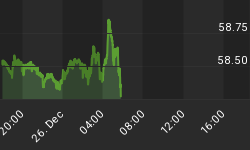The S&P managed to hit the seemingly-important 1,500 level today, before fading to close unchanged. The market took heart early from the print of Initial Claims at 330k. This is of course good news, although some blame may be due to the holiday-shortened week (the BLS had to estimate claims for some states, including California, which were unable to submit their figures in time) and the still-volatile seasonal pattern. Traditionally, this is the week I start paying attention to 'Claims, but each subsequent number matters more than the last. I'd love to hear that the post-holiday layoffs weren't as significant as they usually are, implying that more 'seasonal' workers are being retained. I'm skeptical of it, though, until we see a few more weeks of such evidence or confirmation in the survey numbers.
This is a good time to remember that economic data aren't "right" or "wrong"; they are experiments, like taking the heights of five random motorists and trying to guess the average height of the people who drive on a particular freeway. We never know the true underlying state of the economy, or the true underlying trend rate of any particular economic datum. We come into an economic release with a null hypothesis, and that hypothesis may either be rejected or not rejected (economic data can never really confirm your hypothesis, but they can support your hypothesis). It is for this reason that I ignore the first few Initial Claims figures of the new year. The error bars on them are so wide that it is almost impossible to reject any halfway-rational null hypothesis. Once we have seen a couple more Claims figures in this range, or gotten support for the notion of an improving job market from Consumer Confidence figures (for example), it will be easier to reject the null hypothesis that the economy is still bumping along in a nearly-jobless recovery.
Also today, the TIPS auction produced strong results despite the fact that the market never priced in a 'concession' for the size. At 1:00ET, the bid in the market was -0.62%, but the U.S. Treasury sold $15bln at a lower yield (higher price) of -0.63%. Moving $15bln in size without hitting the bid is a fair sign of hunger in the inflation market.
And why shouldn't there be hunger? If you think the economy is heating up, you can't really short bonds unless you want to sell them and hope the Fed is just about done buying. But the Fisher equation says:
(1+n)=(1+r)(1+i)(1+p), which we usually simplify to say
Nominal rates = real rates + expected inflation
If the Fed is holding nominal rates constant, and investors are expecting inflation to rise as growth heats up (note: I am not changing my view that these are unrelated...I'm merely observing how investors behave in the market), then TIPS ought to stay comparatively well-bid because investors will buy breakevens as the bearish trade, rather than selling Treasuries in a Quixotic attempt to outlast the Fed. I think breakevens and inflation swaps, which remain near the highest levels since 2006 (in the 10-year sector) and near the highest levels since there have been TIPS, are going to remain pretty well bid.
The last data of the week are the New Home Sales (Consensus: 385k from 377k) from December. The forecast is for the highest level of sales in several years, and the biggest hurdle seems to be that inventories of homes remain very low.
One quick observation about home prices and "inflation expectations" that is interesting. Pollster Rasmussen reported today that 29% of Americans expect their home's value to rise over the next year. While this is close to the highest levels the survey has recorded (it was only started in April 2010), it is strikingly low considering that both new and existing home sales prices are up at a double-digit pace over the last year, and even the slower-moving Case-Shiller index has home prices up at over twice the rate of core inflation (4.31% as of October, the last available data, with next week's release expected to be 5.6%). The point simply being this: the Federal Reserve relies mightily on the assumption that inflation cannot really get started when inflation expectations are well-anchored. But nowhere are inflation expectations better anchored, probably, than in home prices - and yet, home prices are rising at something not far away from the peak rates of a couple of years ago.
That's something to think about. Maybe it's time that the Fed dropped the whole notion of anchored inflation expectations, which no one has ever demonstrated since there are no good measures of consumer inflation expectations. The idea of an inflation-expectations anchor was developed to explain why inflation did not accelerate in the 1990s even while the economy did, causing previously-estimated models to breakdown. There are other explanations that don't require positing an anchor that cannot be measured (for example, the private/public debt ratio plays an important role in my company's models), but the imaginations of the academic community became...well...anchored to the idea. It's time to drop that anchor...at least until we develop a way to measure those expectations, and then to test the idea.
















